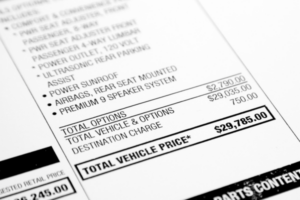
Get a grip on the driveaway price
We have all seen the glossy car ads trumpeting the driveaway price or “drive away, no more to pay”. Dealers typically promote these packages when they are looking to shift greater volumes or make way for next year’s stock.
But what does this sales pitch actually mean? Does the driveaway price include stamp duty? What about if you want to add accessories? Do you have to pay for insurance separately?
A driveaway price should include everything you need to pay to drive out of the dealership as the legal owner of the vehicle. What is included, however, can vary depending on where you buy your car, the type of car, how much it costs, and any modifications made.

It is important that you understand the total cost of the car, rather than just the price listed on the windscreen or website. If it doesn’t say driveaway price or similar next to the amount you could be in for some hefty extras.
What is included in the driveaway price?
Ask the dealer you are buying from to list everything the driveaway price covers. Generally, it includes the cost of the car, plus GST, as well as:
Stamp duty
This is the fee you must pay when a car is registered in your name, whether the car is new or secondhand. Stamp duty, also known as registration duty or motor vehicle duty, is calculated on the list price for new cars or the market value for used cars. It’s a state impost that varies considerably, depending on where you buy your car, the type of car (e.g. hybrid or electric) and how much it costs.
Registration fee
All driveaway prices include registration of the vehicle. This generally means 12 months registration, but some dealers only offer three to six months. The Australian Competition and Consumer Commission (ACCC) says the dealer should advise if it is less than 12 months, rather than leave you to find it in the fine print.
Limited insurance
Compulsory third party insurance (CTP) is included in the car’s registration in most states, though some require you to nominate a private insurer. It covers you for compensation in the event you cause an accident that injures someone else. If you want comprehensive car insurance, you should organise this separately before you leave with your new car.
Dealer delivery
This is the price to get your vehicle from the factory to the dealership, and covers things such as transit fees, detailing, final inspection and the fitting of any accessories.
Luxury car tax
If the car you are buying costs above a certain amount, it will attract a luxury car tax. This is incorporated into the amount advertised, so it's part of the driveaway price. It’s best to check with the Australian Taxation Office that the amount listed is accurate.
What are on-road costs?
This is a separate way of pricing a vehicle. If you are a good negotiator, you might prefer to buy on the list price and try to get a better deal on all the “extras”, or on-road costs.

By law, the listed price must include GST and the luxury car tax. On-road costs include items listed above, such as stamp duty, registration and CTP. As the price for those is set by the state or territory in which you live, there is generally no wiggle room.
It could, however, help you determine whether you buy one model over another, as the stamp duty and registration go up as the price does. The more accessories you add to the car, such as tinted windows or roof racks, the more stamp duty you pay, so that is worth bearing in mind.
Where you might be able to get a deal is in the dealer delivery charges. As outlined above, this is what a dealer charges consumers to ensure the car is good to go. How much you can get off the price will depend on things such as how much it costs the dealer to get the car you want from the factory, how their sales figures are tracking, and the popularity of the model you’ve chosen. If the car is the only one available in the colour you want, for example, you may be less inclined to push for a discount. But it’s always worth haggling, given the fee can be anything between $1000 and $8000.
The Australian Competition and Consumer Commission (ACCC) maintains that if the dealer is selling at a list price, plus on-road costs, this should be stated as clearly as the driveaway price.
Holding dealers to account
Under Australian Consumer Law, there are strict rules around how dealers can advertise car prices, which are overseen by the ACCC.
Dealers can use component pricing, for example, but only if the figure for the total price “is advertised at least as prominently as the most prominent component”. So, if a dealer lists a car for sale for $20,000, but then has broken out components such as stamp duty, dealer delivery, registration and CTP separately, the total price that includes all those on-road costs must be shown as big as the $20,000.
Buying a car is a significant expense so don’t be afraid to question the costs outlined, whether they are listed as driveaway price, or plus on-road costs. If you believe you have been ripped off by a dodgy car salesman, be sure to follow our tips for redress.
Or get in touch directly and lodge a complaint with us.






